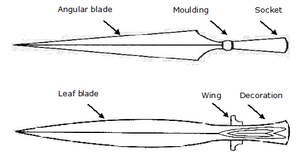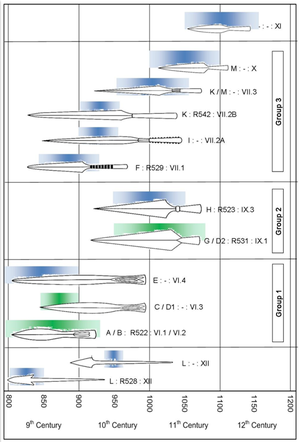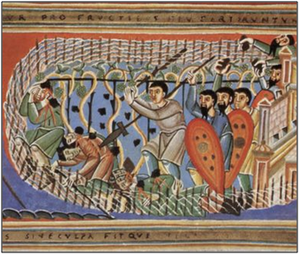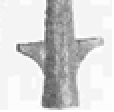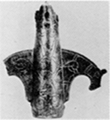Difference between revisions of "Spears"
m (→References) |
m |
||
| Line 12: | Line 12: | ||
}} | }} | ||
<br> | <br> | ||
| + | test | ||
If one ignores Oakeshott’s [OAKESHOTT 1960] rather short and glib analysis of spears in his seminal work ‘The Archaeology of Weapons’ then you quickly realise that spears follow fashion changes by time and region in much the same way as swords. Although not as glamorous as the sword, the spear was in every sense the definitive weapon of the Viking Age and used as the primary weapon of combat by almost every warrior. Decorated spearheads inlaid with precious metals prove that in the Viking Age spears were not seen as the poor man’s choice and one has only to look at the representations of warriors from the illuminated manuscripts of the era to quickly come to the conclusion that the use of the spear was ubiquitous. Many of the Anglo-Saxon phrases used to describe both battle and warrior help to underline the importance of the spear.<br> | If one ignores Oakeshott’s [OAKESHOTT 1960] rather short and glib analysis of spears in his seminal work ‘The Archaeology of Weapons’ then you quickly realise that spears follow fashion changes by time and region in much the same way as swords. Although not as glamorous as the sword, the spear was in every sense the definitive weapon of the Viking Age and used as the primary weapon of combat by almost every warrior. Decorated spearheads inlaid with precious metals prove that in the Viking Age spears were not seen as the poor man’s choice and one has only to look at the representations of warriors from the illuminated manuscripts of the era to quickly come to the conclusion that the use of the spear was ubiquitous. Many of the Anglo-Saxon phrases used to describe both battle and warrior help to underline the importance of the spear.<br> | ||
<br> | <br> | ||
Revision as of 10:10, 30 September 2012
| Spears |
|---|
|
|
A spear is a spear whether it is of the |
|
R.Ewart Oakeshott, The Archaeology of Weapons, 1960 |
test
If one ignores Oakeshott’s [OAKESHOTT 1960] rather short and glib analysis of spears in his seminal work ‘The Archaeology of Weapons’ then you quickly realise that spears follow fashion changes by time and region in much the same way as swords. Although not as glamorous as the sword, the spear was in every sense the definitive weapon of the Viking Age and used as the primary weapon of combat by almost every warrior. Decorated spearheads inlaid with precious metals prove that in the Viking Age spears were not seen as the poor man’s choice and one has only to look at the representations of warriors from the illuminated manuscripts of the era to quickly come to the conclusion that the use of the spear was ubiquitous. Many of the Anglo-Saxon phrases used to describe both battle and warrior help to underline the importance of the spear.
Art
Numerous Anglo-Saxon and Carolingian sources depict the use of the spear being used one handed in an overarm style.
Literature
- Caedmon, æsc-plega, “Spear-bearer” is applied to a soldier. [HEWITT 1996: P.28]
- History of Judith, æsc-plega, “play of spears” used as a term for battle [HEWITT 1996: P.28]
- Codex Extoniensis, æsc-stede, “a field of battle” [HEWITT 1996: P.28]
- Beowolf, Eald æsc-wiga, “some old spear warrior” [HEWITT 1996: P.28]
Archaeology
--
Discussion
Manuscript drawings tend to be stylised and often copied older templates. Spears are depicted often and most warriors are seen to be carrying them. Unfortunately the spearheads are usually shown as a simple arrow shape which bears no resemblance to the actual spearheads found in archaeology.
We do have a number of depictions of spears from stone sculptures in Britain. The carving of Christian stone crosses became popular in northern England in the 10th and 11th centuries [RICHARDS 2004]:P.214.
Paul Hill points out that the term æsc is only used to refer to large two-handed, long bladed weapons used by a high status warrior [HILL 2004: p.65]. He then goes on to argue that the term geir was more commonly used.
Spearheads
Art
--
Literature
--
Archaeology
- England. So far I have identified 45 spearhead finds from England. 20 are of type K/M or M. 7 others are of winged form.
- Wales. 2 finds [REDKNAP 2000]:p.53-54
- Iceland. 81 spearheads have been found dating from the Viking Age. They have been found in 56 graves and 22 spearheads have been registered as stray finds. 40 spearheads belong to type K, 3 to type G, 2 to type H, 3 to type I and 1 to type E. The remainder are probably of local manufacture and do not sit easily within Petersen’s typology.[ANDROSHCHUK and TRAUSTADOTTIR 2004]
Discussion
Most spearhead finds dated from 800AD to 1100AD in Britain are single discoveries often from rivers and are dated by their form against Petersen’s typology.
We do however have a few graves in Scotland, the Isle of Man and northern England. Unfortunately most of these were excavated in the 19th Century with only basic notes about the burials being recorded. To make things even worse many of the spearheads from this era have ended up in private collections or have become ‘lost’. Haakon Shetelig [SHETELIG 1940] has helped us here by compiling a series of books of Viking Age finds from England and Scotland. These books list all of the known finds up to 1940 including some that are now lost.
Categorising spears, javelins and arrows
The following size categories are extremely arboratory
Arrow
Javelin
One-Handed Spear
Two-Handed Spear
Spearhead with open or closed sockets
Wheeler used the spear socket to determine the origin of the spearhead. He classed all spears with a split ‘open’ socket as being English in manufacture and those with overlapped ‘closed’ socket as Scandinavian [WHEELER 1935]:p.170. This convention has continued in use to the present day.
Spearhead manufacture
Pollington states that there is a marked increase in standardisation of Spear heads forms compared to the earlier Anglo-Saxon pagan period (covered by Swanton). He makes the case for this being due to the Alfredian burh system and the centralisation of manufacture away from the traditional labour-intensive smithing on a village or estate scale [POLLINGTON 2006: p.137]
Spearhead typology
Petersen created the first and still the most used typology of spearheads for the Viking Age in 1919 [PETERSEN 1919]. His typology is based on finds from Norway and includes some types that are rare or nonexistent in Britain. It must be remembered that Petersen was working on dates derived from associated items found along with his spear-heads in Norwegian pagan burials and that he often commented on the difficulty of precisely dating a specific burial find.
Thålin working on Swedish finds radically simplified Pertersen’s typology into 3 groups based on the method of manufacture. Thålin’s groups are refered to in Graham-Campbell [GRAHAM-CAMPBELL 1980: P.67, P.72] and explained in Fuglesang [FUGLESANG 1980: P.137].
Swanton [SWANTON 1973] presents us with an in depth analysis of spearheads found in pagan Saxon graves in England. Unfortunately this only takes us up to around the time of the Christian conversion, about 700AD. After this our burial record in England disappears with the Christian’s practice of burying their dead with no grave goods.
Solberg re-evaluated Petersen’s work as his 1985 Phd thesis, again working from Norwegian finds. Solberg’s work is discussed in Halpin [HALPIN 2008].
Two settlements from Europe can be used to help corroborate Petersen’s typological dating, Iceland and the town of Birka in Sweden. Both have clear datable horizons that help us to place spearheads into clearly dated periods.
Iceland was probably settled c.874AD and out of the 81 spearheads dated to the Viking Age from Iceland only one falls into Thalin’s group 1. All of the others are from his groups 2 and 3 (K x40, G x3, H x2, I x2, E x1, Unclassified x33) [ANDROSHCHUK and TRAUSTADOTTIR 2004: P.6].
The settlement at Birka came to an end around c.960AD. No spearheads of K/M or M types were found there, which would help confirm a late dating for these sometimes decorated spearheads. [FUGLESANG 1980: P.33]
Both of these settlement horizons help confirm Petersen’s original typological dating.
Leaf shaped heads
Thålin Group 1
| 800-899 | 900-979 | 980-1040 | 1041-1100 |
| Encouraged | Optional | Allowable | |
Leaf shaped heads, Petersen types A(B), C(D1) and E, seem to go out of fashion by 950AD [PETERSEN 1919]. Other people have suggested that a few leaf shaped heads may have continued throughout the period [Citation Needed].
Angular shaped heads with short sockets
Thålin Group 2
| 800-899 | 900-979 | 980-1040 | 1041-1100 |
| Allowable | Optional | Encouraged | Optional |
Group 2 consists of Petersen types D:2, G and H. They are all types with edge shoulders placed low on the blade and a short conical socket with marked narrowing below the blade.
Fuglesang includes the winged spears of Petersens type D2 in with this group as he removed wings as a determinant of typology making Petersens D2 and G types the same. See the section on ‘Winged Spears’ for examples of D2 style spear heads.
It has also been suggested by Fuglesang and Petersen that type G spearheads without wings may be of eastern origin with the majority of finds coming from Sweden and Finland. A few decorated type G spears have been found with Urnes style decoration.
Angular spearheads with long sockets
Thålin Group 3
| 800-899 | 900-979 | 980-1040 | 1041-1100 |
| Optional | Encouraged | ||
Group 3 consists of Petersen types F, I, K & M. They are all types with a narrow blade which is often shouldered and a socket that is long, narrow and conical.
Fuglesang has studied the K & M types of spearhead that are decorated in Ringerike designs. Due to difficulty in determining the exact typology of many of these spearheads she has introduced a new K/M type that falls between those of Petersens K and M.
F – 30cm to 50-60cm, 50-60cm being typical.
Spearheads with attached wings or lugs
Lugged spear-heads of this kind, sometimes referred to as the Carolingian type, are common from Viking contexts from the 9th century onwards, both in Scandinavia and England, but the most recent studies cautiously point out that it can no longer be regarded as exclusively Scandinavian in character.
|
Though Petersen used the lugs as diagnostic features for his typology of spears, recent scholars have very properly challenged the notion that they serve as chronological or stylistic indicators. Because the lugs have a function in preventing too deep a penetration of the blade, this type of spear was used primarily as a hunting weapon, since with it the animal could be more easily held at bay. So successful was it that it survived in use until the end of the Middle Ages. That it was so employed is demonstrated by the 10th-century cross Middleton A, near Pickering, which depicts a stag hunt with the huntsman wielding a lugged spear. Signe Horn Fuglesang's [FUGLESANG 1980: P.136] discussion of such sockets has convincingly removed the lug as a typological factor, and as a chronological criterion too. |
| Lang |
Heavy thrusting spears of this winged type are considered to be 9th century imports from the Carolingian empire. Winged or lugged spearheads in general are discussed by Fuglesang. [GRAHAM-CAMPBELL 1980: P.72]
The winged spear can be seen in a few of manuscripts illustrations and stone carvings.
Types of winged spears
Standard Wings
Backswept Wings
Decorated spearheads
Some of the K, K/M and M types of spearheads are decorated in Ringerike style around the join between the blade and the socket. A group of 24 such ornamented spear-heads of types K, K/M, and M has been discussed by Fuglesang [FUGLESANG 1980]. Only one of these was found in Britain [WHEELER 1927: p.21 Fig.5]. Except for another from Belgium they seem to concentrate in Sweden although as Fuglesang correctly points out, not enough finds have been made to make any firm statements regards regional origins.
Magi-Lougas has devided spearhead decoration into 3 types [MAGI-LOUGAS 1994]
Type I – Silver Decoration
characterised by the use of different metals, or metals of different colours, to form the ornament
E-, I- K- and K-type spearheads, but also in some cases to G-type
Type II – Ringerike Style
1000 – 1060AD
Type III – Runic Style (Urnes)
1025 – 1100AD
Spear shafts
Woods used
Identification of wood from spears in the Baltic region shows that shafts were made of ash, elm or oak. These kinds of woods were used because of their straightness of grain, stiffness, hardness, strength, moderate weight, flexibility, and capacity for being smooth in use [ANDROSHCHUK and TRAUSTADOTTIR 2004]. Spear shafts were likely to be no thicker than 3cm in diameter. [HALPIN 2008]
Attaching the spearhead
A number of methods seem to have been used to secure the spearhead to the wooden shaft.
Art
- Anglo-Saxon manuscripts depict spear heads with one or more lines through the socket. These have been interpreted as possible rivets.Template:Citation needed
Literature
--
Archaeology
- Dublin, 66% of the spearheads from Dublin had rivet holes with the hole size usually being between 2 to 3 mm in diameter [HALPIN 2008: p.134].
- Isle of Man, Balladoyne. A type K spearhead retained traces of a fine linen fabric that had been wrapped twice around the point of the wooden shaft [BJORN and SHETELIG 1940: p.26].
Discussion
Riveting, pinning and gluing were probably the most common.
Painted Spear Shafts
Spear shafts that are painted or stained for decorative effect
Art
Anglo-Saxon manuscripts only show spear shafts as a thin black line. Some Western European manuscripts depict thicker shafts filled in a single colour.
- Life of St Aubin, Angers Abbey c.1100AD
Literature
--
Archaeology
--
Discussion
Currently we have no evidence for spear shafts being painted in more than one colour from the Viking Age.
Carved Spear Shafts
Spear shafts that have been carved for decorative effect
Art
--
Literature
--
Archaeology
--
Discussion
--
Using spears two-handed with a slung shield
| 800-899 | 900-979 | 980-1040 | 1041-1100 |
| Allowable | |||
{Evidence| |Art= There are no depictions of spears being used two-handed with a slung shield from the Viking age. What evidence we do have comes from before or after the Viking age and depict combat against either horses, ships or castles.
- Scotland, Aberlemo stone. Depicts a warrior attacking a mounted warrior.
- England, Canterbury. Stained glass window dated to ??. Depicts a warrior attacking a castle.
- Germany. Unknown manuscript C12th. Depicts a warrior attacking a ship.
|Literature
|Archaeology
|Discussion =
Two-handed spear combat evolved in the 1980’s as a way of winning re-enctment battles [SIDDORN 2005]. Using a spear in this fashion has one huge disadvantage, you cannot defend your head with your shield! Having said this I do beleave that some of the large headed winged spears could of possibly been used two-handed as both hunting spears and combat spears. A counter argument to this is the dipiction of warriors using winged spears one-handed in the Codex Aureus Epternacensis illustrated in c.1040AD.
In summary I think that it would be unusual to see a spear being used in a two-handed fashion on the battle field and any that were would be high status hunting winged spears.
}}
See Also
Catalogue of spearheads found in England
Throwing Spears
References
<nocite> ANDROSHCHUK2004 FUGLESANG1980 GRAHAM-CAMPBELL1980 HALPIN2008 HEWITT1996 HILL2004 WHEELER1927 </nocite> <biblio force=false>#Template:Bib</biblio>
- [KENDRICK 1949] Kendrick, T.D. Late Saxon and Viking Art. Butler and Tanner, 1949.
- [LANG 1981] ^ Lang, J.T. "A Viking Age Spear-Socket from York." Medieval Archaeology, 25, 1981: 157–160.
- [MAGI-LOUGAS 1994] ^ Magi-Lougas, Marika. “On the Relations between the Countries around the Baltic as Indicated by the Background of Viking Age Spearhead Ornament.” 1994.
- [OAKESHOTT 1960] ^ 1 2 Oakshott, Ewart. The Archaeology of Weapons. Lutterworth Press, 1960.
- [PETERSEN 1919] ^ 1 2 Petersen, Jan. De Norske Vikingesverd. 1919.
- [REDKNAP 2000] ^ Redknap, Mark. Vikings in Wales. An Archaeological Quest. National Museums & Galleries of Wales, 2000.
- [RICHARDS 2004] ^ Richards, Julian D. Viking Age England. Tempus, 2004.
- [SHETELIG 1940] ^ Shetelig, Haakon. Viking Antiquities in Great Britain and Ireland Part 4, VIKING ANTIQUITIES IN ENGLAND. 1940.
- [SWANTON 1973] ^ Swanton, M. J. The Spearheads of the Anglo-Saxon Settlements. The Royal Archaeological Institute, 1973.
- [WHEELER 1935] ^ Wheeler, R.E.M. London and the Saxons. London Museum Catalogues: No 6, 1935.
